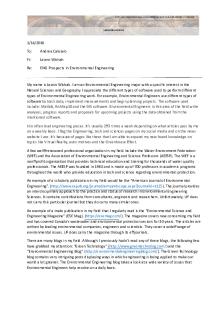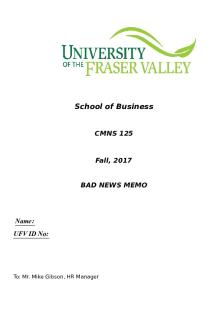Law204 (3) Legal Memo PDF

| Title | Law204 (3) Legal Memo |
|---|---|
| Course | Legal Analysis in Bus Context |
| Institution | Ryerson University |
| Pages | 3 |
| File Size | 85.5 KB |
| File Type | |
| Total Downloads | 4 |
| Total Views | 144 |
Summary
This is a memo in legal writing taught in class...
Description
To: Aliya Ramji, Lawyer From: Michela Nucci Date: March 1, 2021 RE: Sam Gamgee, Gamgee v. Poppins Case - Legal Action for Privacy Invasion Questions Presented Sam Gamgee’s private information was accessed and exposed on Facebook by his girlfriend Mary Poppins. The issue at stake is whether or not he will be able to sue her for the legal doctrine that applies to this case. Short Answer I believe that Sam can sue Mary for a breach of invasion of privacy. Despite his suspicious actions, she took the initiative to handle his private information without his consent. Background Sam Gamgee was banned from several social media sites, dismissing his access to his personal accounts. Since he had been engaging in suspicious behaviour, Mary became concerned and quickly took the action to get into his phone and access his private messages with another woman. She monitored this behaviour for four months and eventually revealed her knowledge. Mary not only took screenshots and sent them to herself, but she entirely exposed the messages on Facebook, a social media site he does not have current access to and is known for saving users’ private information. Sam became aware through his local news station and wants to take legal action on Mary exposing his private affairs without his consent.
Discussion Jones v Tsige, 2012 ONCA 32 In this case, the statement of issue was if Ontario law recognized a cause of action for the tort of invasion of privacy. The court confirmed a right of action for intrusion upon seclusion, in which the invasion of privacy is held under. Liability for the defendant is based on intention, invasion of private affairs without lawful justification, and high offense to a reasonable person. When comparing this case to Sam v. Mary, I can infer that Mary’s actions have passed the legal test for intrusion upon seclusion. She intended to publicly post his private messages, invaded his private affairs without permission, and a reasonable person would regard her post as highly offensive/cause mental distress as Sam was livid. Jones was awarded damages and according to this preceding, Sam should be granted damages through compensation.
Jane Doe 464533 v. D. (N.) 2016 ONSC 541 In this case, Jane’s explicit photos were put onto the internet without consent after her boyfriend begged for photos that she did not want to send. The statement of issue is formal acknowledgement of the seriousness of cyber-bullying; a threat to a right of privacy, and if the defendant’s actions constituted intentional infliction of mental distress. The Court proposed a new tort in relation to privacy rights, known as Public Disclosure of Private Facts and it is defined by “one who gives publicity to a matter concerning private life of another is subject to liability to the other for invasion of the other’s privacy, if the matter publicized or the act of the publication (a) would be highly offensive to a reasonable person, and (b) is not of legitimate concern to the public.” N.D’s actions fall under both section (a) and (b) of the rule of law. This affects Sam’s case because the Court held that permitting someone who has been trusted with personal details and intimate images to reveal to the world over the internet without legal recourse would be to leave a gap in the system of remedies. Mary is further proven liable to Sam for going against his privacy rights, which have been afforded constitutional protection and considered a value in the Charter. The court concluded that the defendant in the Doe v. N.D. Case intended infliction of distress as he was aware that his girlfriend was hesitant from the beginning. The plaintiff claimed several kinds of damages as the defendant’s actions “offended and compromised the plaintiff’s dignity and personal autonomy.” The court ordered injunctive relief. In Sam’s case, Mary knew she would be ruining Sam’s reputation and caused him plenty of anger and distress. Sam can potentially be awarded damages of compensation and injunction. Kaplan v. Casino Rama, 2019 ONSC 2025 In this case, the statement of issue is the judge’s discovery of a cause of action for the tort of negligence due to their lack of security, breach of contract; refusal to pay the ransom offered by the hacker, and intrusion upon seclusion of individuals whose information was posted online. Under the Class Proceedings Act, 1992, S.O. 1992, there is evidence required to certify a cause of action and that is; (a) common but not necessarily identical issues of fact, or (b) common but not necessarily identical issues of law that arises from common but not necessarily identical facts. The court concluded there were no common issues among all individuals. This is because there were a number of individual investigations as different types of information was hacked for each individual. Thus, a class action lawsuit cannot be justified as the selected procedure. This case affects Sam’s case in the aspect of security of a company and personal security. It is a lack of trust in not only companies that individuals invest in but the people we invest in and the technology involved with the relationships.
Conclusion Based on the three cases thoroughly read and analyzed, these prior proceedings encourage my initial belief. I continue to be of the opinion that Sam Gamgee can sue Mary Poppins for invasion of privacy under intrusion upon seclusion. I also believe that there is a cause of action for a tort
of public disclosure of private facts and breach of confidence. Mary’s actions were entirely intentional and highly offensive to a reasonable person, despite Sam’s questionable behaviour prior to the incident....
Similar Free PDFs

Law204 (3) Legal Memo
- 3 Pages

Legal Memo on Arson
- 13 Pages

244556089 Legal Memo 1 - cases
- 5 Pages

Memo of Test 3.
- 3 Pages

Memo - Memo
- 2 Pages

Memo - Business Memo Assignment
- 2 Pages

Legal Method Tutorial 3
- 11 Pages

Memo - Memo for stocks
- 2 Pages

Memo 1 - Memo 1 Assignment
- 2 Pages

Laptop Memo - BIT-200 Memo
- 2 Pages

ITRW 315 Class Test 3 MEMO 2017
- 2 Pages

Sac 3 notessss - legal notes 3
- 3 Pages
Popular Institutions
- Tinajero National High School - Annex
- Politeknik Caltex Riau
- Yokohama City University
- SGT University
- University of Al-Qadisiyah
- Divine Word College of Vigan
- Techniek College Rotterdam
- Universidade de Santiago
- Universiti Teknologi MARA Cawangan Johor Kampus Pasir Gudang
- Poltekkes Kemenkes Yogyakarta
- Baguio City National High School
- Colegio san marcos
- preparatoria uno
- Centro de Bachillerato Tecnológico Industrial y de Servicios No. 107
- Dalian Maritime University
- Quang Trung Secondary School
- Colegio Tecnológico en Informática
- Corporación Regional de Educación Superior
- Grupo CEDVA
- Dar Al Uloom University
- Centro de Estudios Preuniversitarios de la Universidad Nacional de Ingeniería
- 上智大学
- Aakash International School, Nuna Majara
- San Felipe Neri Catholic School
- Kang Chiao International School - New Taipei City
- Misamis Occidental National High School
- Institución Educativa Escuela Normal Juan Ladrilleros
- Kolehiyo ng Pantukan
- Batanes State College
- Instituto Continental
- Sekolah Menengah Kejuruan Kesehatan Kaltara (Tarakan)
- Colegio de La Inmaculada Concepcion - Cebu



